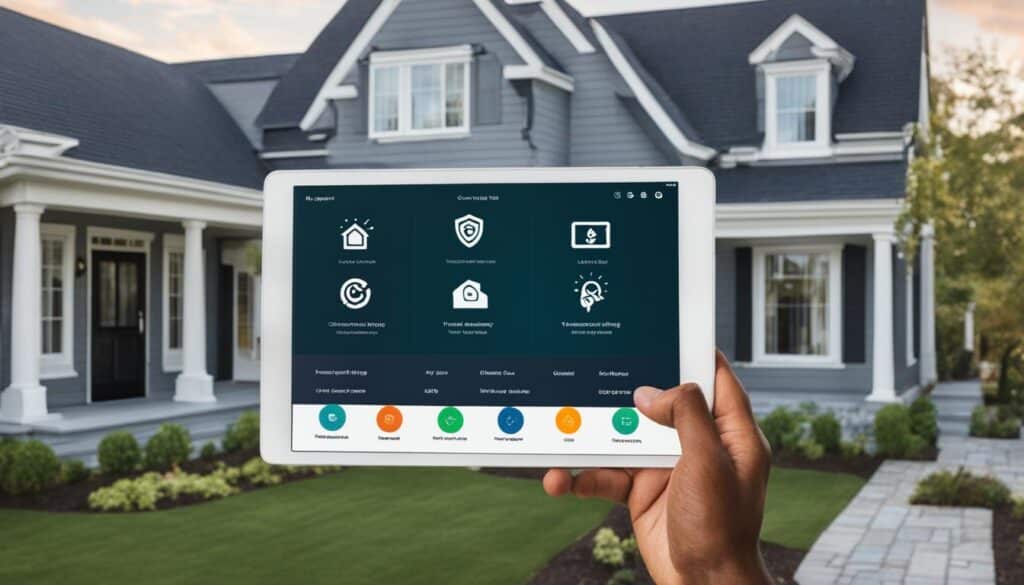Smart homes are becoming increasingly popular, offering convenience and efficiency to homeowners. However, maintaining a smart home can sometimes be overwhelming, especially for beginners. In this article, I will provide you with essential tips to help you effectively maintain your smart home and keep it running smoothly. These tips will cover various aspects of smart home maintenance, including security, software updates, device connectivity, and energy management.
Table of Contents
Key Takeaways:
- Regularly update your smart home devices and software to ensure security and privacy.
- Optimize device connectivity by upgrading your home network and strategically placing devices.
- Stay up to date with software and app updates for optimal performance.
- Manage energy consumption using smart home features to reduce costs and promote sustainability.
- Following these essential maintenance tips will help you enjoy the benefits of a smart home while keeping it running smoothly.
Ensure Regular Security Updates
One of the most important aspects of smart home maintenance is ensuring regular security updates. Smart home devices are connected to the internet, making them vulnerable to cyber threats. To protect your smart home from hackers and malware, it is crucial to keep all your devices and software up to date.
Regularly checking for firmware updates and security patches released by manufacturers and promptly installing them is essential. By doing so, you can ensure the security and privacy of your smart home, safeguarding it from potential risks.
Here are a few key steps to follow:
- Check for updates regularly: Set a schedule to check for updates on your smart home devices and software. This ensures that you stay informed about the latest security updates and patches available.
- Install updates promptly: When updates are available, promptly install them on all your devices. Delaying updates can leave your smart home vulnerable to potential security breaches.
- Enable automatic updates: Many smart home devices have an option to enable automatic updates. By enabling this feature, updates will be installed automatically, reducing the manual effort required on your part.
“Regularly updating your devices and software is a crucial step in maintaining a secure smart home” – John Smith, Smart Home Expert
By implementing these measures and staying proactive with security updates, you can enhance the safety of your smart home and ensure a secure environment for you and your family.
Optimize Device Connectivity
Another key aspect of smart home maintenance is optimizing device connectivity. In a smart home, multiple devices are interconnected, communicating and sharing data with each other. To ensure smooth operation, it is important to have a reliable and robust network. Consider upgrading your home network to a mesh Wi-Fi system, which provides better coverage and eliminates dead zones. Additionally, placing your smart home devices strategically can improve connectivity and reduce signal interference.
By strategically placing your devices, you can optimize their connectivity and improve performance. Here are a few tips:
- Place your smart home hub in a central location to ensure it has a strong signal reach.
- Keep your devices away from physical obstacles that can block or weaken Wi-Fi signals, such as walls or large furniture.
- Avoid placing devices near other electronics that may cause signal interference, such as microwaves or baby monitors.
- If you have multiple floors in your home, consider placing Wi-Fi extenders or access points strategically to ensure coverage throughout your entire space.
Optimizing your device connectivity not only enhances the performance of your smart home but also improves the overall user experience. A well-connected smart home allows for seamless control and automation, making your life easier and more convenient.

Benefits of Optimized Device Connectivity
Optimizing device connectivity in your smart home offers several benefits:
- Reliable operation: With an optimized network, you can enjoy reliable and uninterrupted connectivity between your devices, ensuring they respond promptly to your commands.
- Efficient data transfer: A robust network minimizes data transfer delays, ensuring quick and efficient communication between your smart devices.
- Enhanced automation: When your devices are well-connected, automation commands are executed smoothly, improving the efficiency and effectiveness of your smart home.
- Seamless streaming and gaming: With optimized connectivity, you can enjoy seamless streaming of media content and lag-free gaming experiences.
- Reduced frustration: By eliminating connectivity issues and dead zones, you can avoid the frustration of devices not responding or experiencing lag.
By following these tips and optimizing device connectivity in your smart home, you can ensure a smooth and reliable experience, allowing you to fully enjoy the benefits of your smart devices.
Regularly Update Software and Apps
Keeping your smart home software and apps up to date is crucial for maintaining optimal performance. Manufacturers often release software updates and bug fixes to improve functionality and address vulnerabilities. Set up automatic updates for your smart home hub, apps, and connected devices, so you don’t miss any important updates. Regularly check for updates manually to ensure that your smart home is running on the latest software versions.
By regularly updating your smart home software and apps, you can:
- Enhance overall performance and stability
- Access new and improved features
- Ensure compatibility with other devices and systems
- Protect against security risks and cyber threats
The Importance of Automatic Updates
Enabling automatic updates for your smart home hub, apps, and connected devices is a convenient way to ensure that you are always running the latest software versions. Automatic updates:
- Save time and effort: With automatic updates, you don’t have to manually check for updates or go through the update process for each device or app.
- Ensure timely security patches: Manufacturers often release security patches to address vulnerabilities and protect your smart home from potential threats. Automatic updates help you stay protected without delay.
- Improve performance and functionality: Software updates may include performance optimizations, bug fixes, and new features that enhance the overall functionality and user experience of your smart home.
However, it’s also important to occasionally check for updates manually, especially for critical software components like your smart home hub. This helps ensure that you haven’t missed any updates that were not installed automatically.
How to Check for Updates Manually
Checking for software updates manually is a simple process that allows you to verify that your smart home is running on the latest software versions. Follow these steps to check for updates:
- Open the app or interface of your smart home hub.
- Navigate to the settings or preferences section.
- Look for an option related to “Software Updates,” “Firmware Updates,” or “System Updates.”
- Select the update option and follow the prompts to check for and install any available updates.
Be sure to regularly repeat this process for all your connected devices and apps to ensure that everything is up to date.
Regularly updating your smart home software and apps is an essential part of maintaining your smart home. By staying up to date with the latest software versions, you ensure optimal performance, improved functionality, and enhanced security for your smart home ecosystem.
Manage Energy Consumption
One of the benefits of a smart home is the ability to manage and reduce energy consumption. By utilizing the energy management features offered by smart home devices, you can make your home more energy-efficient and environmentally friendly.
An essential component of smart home energy management is the use of smart thermostats. These devices allow you to optimize heating and cooling in your home based on your schedule and occupancy. With a smart thermostat, you can set customized temperature settings for different times of the day, ensuring that energy is not wasted when you are not at home. This can help you reduce both your energy consumption and utility bills.
In addition to smart thermostats, smart power strips are another valuable tool for managing energy in your smart home. These power strips enable you to control and monitor the energy usage of your devices. By connecting your electronics to a smart power strip, you can easily turn them off or put them into standby mode when they are not in use, minimizing the energy wasted by devices on standby.
Moreover, you can maximize energy efficiency in your smart home by leveraging automation features. Programmable routines and schedules allow you to automatically turn off lights and appliances when they are not needed. For example, you can set your lights to turn off automatically when you leave a room or have them dim during specific hours of the day. This level of automation eliminates the possibility of leaving lights or appliances on unnecessarily, reducing energy consumption without any extra effort.

To summarize, managing energy consumption is a key aspect of smart home maintenance. By using smart thermostats, smart power strips, and automation features, you can effectively reduce energy waste and lower your carbon footprint. Not only will this benefit the environment, but it will also result in cost savings on your energy bills. Embrace the power of smart home energy management and enjoy the advantages of a greener and more efficient home.
| Energy Management Tips for Smart Homes |
|---|
| – Use smart thermostats to optimize heating and cooling based on your schedule and occupancy |
| – Install smart power strips to control and monitor the energy usage of your devices |
| – Leverage automation features to turn off lights and appliances when they are not in use |
Conclusion
Now that you have learned the essential tips for smart home maintenance, it’s time to put them into practice. By following these guidelines, you can ensure that your smart home operates smoothly and efficiently.
First and foremost, prioritize the security of your smart home by regularly updating your devices. Keeping your firmware and software up to date will protect your home from potential cyber threats.
Next, optimize device connectivity to enhance the performance of your smart home. Consider upgrading your home network and strategically placing your devices to minimize signal interference.
Stay on top of software and app updates to take advantage of new features and improvements. Set up automatic updates to ensure that your smart home always runs on the latest software versions.
Lastly, manage energy consumption to save costs and promote sustainability. Utilize energy management features offered by your devices and leverage automation to reduce unnecessary energy usage.
By implementing these smart home maintenance tips, you can enjoy the convenience and efficiency of your smart home while keeping it running smoothly for years to come.
FAQ
How often should I update the security of my smart home devices?
It is recommended to regularly check for firmware updates and security patches released by manufacturers and install them promptly to ensure the security and privacy of your smart home.
What can I do to improve the connectivity of my smart home devices?
Consider upgrading your home network to a mesh Wi-Fi system, which provides better coverage and eliminates dead zones. Additionally, placing your smart home devices strategically can improve connectivity and reduce signal interference.
How important is it to keep my smart home software and apps up to date?
Keeping your smart home software and apps up to date is crucial for maintaining optimal performance. Set up automatic updates for your smart home hub, apps, and connected devices, and regularly check for updates manually to ensure that your smart home is running on the latest software versions.
How can I effectively manage the energy consumption of my smart home?
Take advantage of energy management features offered by your smart home devices. Use smart thermostats to optimize heating and cooling based on your schedule and occupancy. Install smart power strips to control and monitor the energy usage of your devices. Additionally, leverage automation features to turn off lights and appliances when they are not in use, maximizing energy efficiency.


